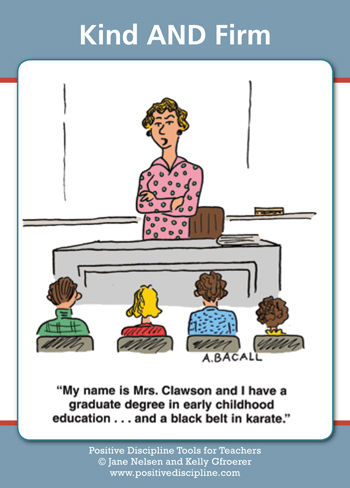Below is an excerpt from Positive Discipline Tools for Teachers by Jane Nelsen and Kelly Gfroerer.
As a teacher, do you have a tendency toward being a little too kind, and have difficulty being firm? (You don’t want to be one of those mean, autocratic teachers.) Or are you a little too firm because you think kindness can be wishy-washy? (You don’t want to be one of those permissive teachers.) Is it your tendency to be kind until misbehavior occurs, and then too firm? A cycle of vacillating between too kind and too firm is easy to fall into, especially when you teach large class sizes with challenging classroom dynamics.
Your reaction to student behavior does not have to be either too kind or too firm. Rudolf Dreikurs promoted the respectful method of kind and firm at the same time. Students thrive when they trust that they will consistently be met with kindness, even when they make mistakes. At the same time, they learn order when they know that established rules and expectations are firmly in place. Being kind and firm communicates, “I care and understand, and you are still accountable.” This congruent response expresses a sense of faith in your students’ ability to handle tough situations and challenges at school.
While most teachers readily recognize the benefits of democratic leadership (cooperative problem-solving) as opposed to autocratic leadership (“I am the boss, do as I say”) and laissez-faire leadership (no structure and often too permissive), it can be difficult to be consistently kind and firm in the classroom if there is no plan in place. To avoid an inconsistent and ineffective back-and-forth between kindness and firmness, Positive Discipline teaches specific language that is both kind and firm. Some teachers find it helpful to write phrases on Post-it notes to serve as a visible reminder. Teachers report that memorizing even a few key phrases helps as they walk the difficult line of consistently implementing kind and firm democratic leadership in the classroom.
Here are some examples of sentences that will help:
- Validate feelings: “I can tell you are upset about something, and it is time to be working on your project. I’m available after school if you would like to talk about why you’re upset.”
- Show understanding: “I can understand why you would rather be doing something else right now, and your assignment needs to be done first.”
- “I” message: “You don’t want to do your homework, and I don’t want you to fail. Let’s find time to talk about what you need to succeed.” Follow through on a previously made agreement: “I noticed you didn’t hand in your assignment on time, and what was our agreement about when it would be done?” Kindly and quietly wait for the answer.
- Provide a choice: “I know you would prefer to play games now, and it is quiet time. Would you like to put the toy in your backpack or should I hold on to it for you?”
Even though these are scripts, remember that tools are effective only when based on sound principles and when you then add your heart and wisdom to use your own words to fit the situation. If using kindness and firmness is not effective, it could be that you are involved in a power struggle, or not understanding some other discouraging belief behind a student’s behavior. It may be time for relationship building through other Positive Discipline tools such as special time, curiosity questions, or joint problem-solving during class meetings.
Tool in Action from Lima, Peru
The philosophy of Positive Discipline which intends to apply kindness and firmness at the same time, understand emotions, empower children in the search for solutions, and assume mistakes are great opportunities to learn—opened my eyes to new ways of managing classroom behaviors.
I have been applying Positive Discipline for two years. The first year, my fellow teachers told me, “Of course, it worked for you because you had a high-quality group.” The second year I was assigned a very difficult group of students, and my colleagues said, “Let us see now if you will be able to apply Positive Discipline.” That made me even more eager to strive to be kind and firm at the same time.
At the end of the year my colleagues observed how much my group had advanced, and they appreciated the work I had done with my students. They realized that what I had done (and what I had proposed to them for their own classrooms) could be successful because they saw the positive changes in the children. In addition, the teacher who received my students from last year found that the children established routines easily without being told, that they had the ability to resolve problem situations and self-regulate, and that they could hear each other with respect and empathy. She asked me how to continue the work I had begun, and I was able to convey my understanding and experiences to her. Now she is encouraging her fourth-grade partners to apply the Positive Discipline tools.
—Sandra Colmenares, third-grade teacher, Certified Positive Discipline Educator



No Comments yet!